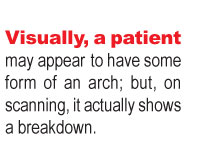With the approach of summer, more of our patients are turning their attention to getting outdoors and exercising. Activities can range from walking to the mailbox to running local 5K races. Regardless of our patients’ activity levels, an important factor in keeping them out of pain is addressing the shoes they are wearing.
Different Activities, Different Needs
Commonly, someone who begins a walking or running program may not take into consideration the equipment necessary to embark on their journey. They wear the same shoes that they wear to mow the lawn or take the garbage out. For someone who is only going to walk or jog a couple blocks, this may be alright; but, for anyone who is going to consider ramping up the mileage, the correct shoe types are essential.
The Three Types of Feet
Normally, we believe that people can have one of two types of feet; those that are flat and those that are not. Technically, this is incorrect; we actually have three types of feet. The first type is a supinated foot, which is usually associated with the higher arch and weight distribution that is a bit more lateral. This foot also demonstrates a footprint of a “C” shape. The second type is referred to as a neutral foot, which has a slight or semi-curve to it, and still maintains an arch upon sight inspection. This foot will have weight distribution that usually transitions through the midline of the foot. The third foot type is the flat foot or hyperpronated foot. This imprint is usually wider and straighter in appearance.
Keeping these points in mind, running shoes are designed the same way. Once you know your foot type, you should make sure your running shoes match accordingly. The supinated shoe is usually narrower and has a curved last. The neutral shoe will have a semi-curve to its last, while the hyper-pronated shoe is usually straight. In literature, you will see this shoe referred to as the “motion-control” shoe. This terminology comes from the shoes being designed to support the foot and prevent excessive hyperpronation.
What Type Are You?
How do we determine which foot types we are? You could always wet your feet and step onto a piece of dark construction paper or a brown grocery bag. The best clinical way is to use a digital scanner. By scanning your patients’ feet, this will not only show you the foot types they possess, but may also show weight bearing imbalances that affect the normal movement pattern of the foot. These imbalances are a result of a breakdown of the anterior, lateral, or medial arches. One or all three of the arches can become involved. Visually, a patient may appear to have some form of an arch; but, on scanning, it actually shows a breakdown. This can be more visual after the foot has been weight bearing and has not been supported properly. This results in what is referred to as plastic deformation, where the aponeurosa of the plantar fascia can no longer maintain its normal length due to being overstretched from repetitive microtrauma.

Now, what?
Once we have determined our foot type, we need to determine whether or not there is a need for custom-made flexible orthotics based on the scanner results. Keep in mind the importance of making sure the orthotics fit properly into the patient’s running shoes. We want to make sure the patient first takes out the store insole. This allows orthotics to fit more securely within the shoe. It is also very important, in future purchases of shoes, that our patients make sure they take their orthotics with them to place them into any new shoes they may purchase.
Another important component of the shoe structure is the shock absorbency and rigidity of the shoe. A shoe designed for a supinator is usually designed with more shock absorbency. This is due to the supinated foot’s being a very rigid foot which will absorb a lot of stress. The neutral foot and the hyperpronated foot disburse a lot of the stress they receive due to their being more flexible.
Often I am asked, will the motion control shoe be enough to support the foot when it hyperpronates? The answer is no, the reason being that, even though the shoe is designed to control the hyperpronation or medial rolling of the midfoot, it still is not designed to support all the arches as a custom-made flexible orthotic would. A great custom-made flexible orthotic and a great shoe are a perfect combination to help our runners and walkers get the best benefits to allow them to participate in a pain-free, active lifestyle.
A 1980 graduate of Palmer College of Chiropractic, Dr. Kirk Lee is a member of the Palmer College of Chiropractic Post Graduate Faculty and Parker College of Chiropractic Post Graduate Faculty. He has lectured nationwide on sports injuries and the adolescent athlete, and currently practices in Albion, Michigan. Dr. Lee can be reached at [email protected].
